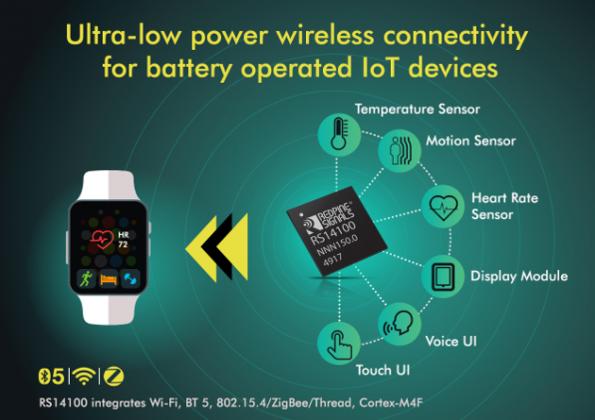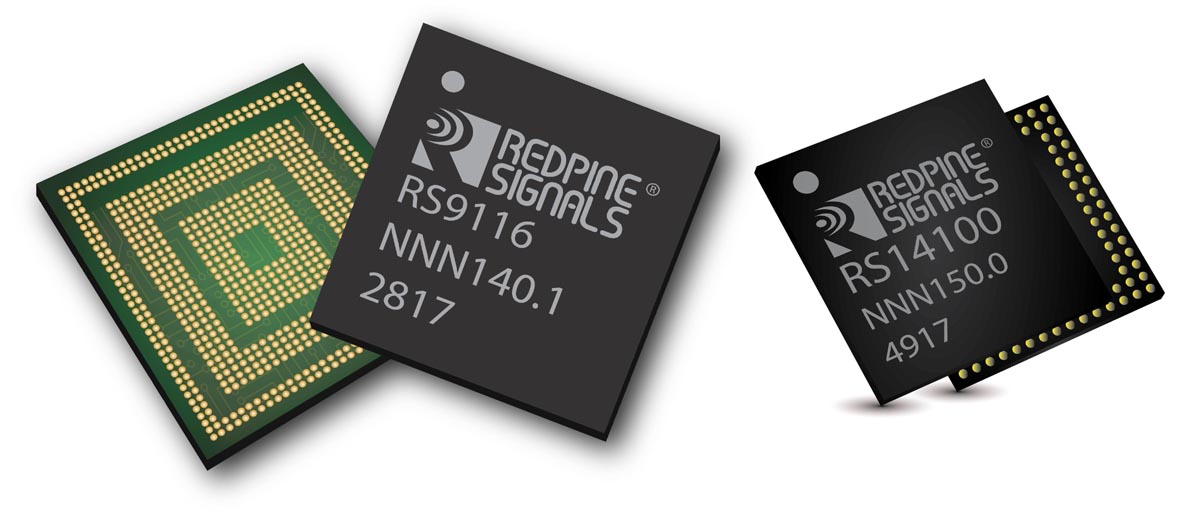Feature advanced security with integrated Bluetooth 5, dual-band Wi-Fi, 802.15.4/ZigBee/Thread and ARM Cortex-M4F application processor
Redpine Signals launched the industry’s lowest-power multi-protocol wireless MCU (WiSeMCU™) solution - RS14100 - for battery-operated IoT devices. Redpine Signals also launched the RS9116 wireless solution, which features multi-protocol wireless connectivity and is available in both hosted (n-Link™) and embedded (WiSeConnect™) configurations. These new low-power solutions build upon the success of Redpine’s RS9113 and RS9110 devices, which together have been in production for over a decade and have been deployed by thousands of IoT customers worldwide.

The RS14100 and RS9116 implement multi-protocol wireless connectivity with dual-band (2.4/5 GHz) 802.11abgn Wi-Fi®, Bluetooth® 5 (including long range, high throughput and advertising extensions) and 802.15.4 which can be used for Thread or ZigBee® connectivity. The RS14100 features an ARM® Cortex®-M4F which can operate up to 180 MHz and includes up to 4 MB of flash for applications. Users can choose from various SoC and module packages based on their system requirements, including the industry’s smallest integrated module at 4.6 mm × 7.8 mm. The WiSeConnect embedded modules provide an industry-high throughput of over 90 Mbps with integrated wireless stacks, wireless profiles and networking stack. n-Link hosted modules interface to processors running Linux, Android or Windows operating systems.

The RS14100 and the RS9116 feature a patent-pending ‘big-little’ architecture at every level including MCU, Wi-Fi, Bluetooth 5 and 802.15.4, providing optimized transitions between high-performance and low-power operating modes. This unique architecture enables the industry’s lowest Wi-Fi standby associated power of <50 µA, an ARM® Cortex®-M4F that can provide as low as 15 µA/MHz operation, and integrated Bluetooth 5 which has lower power than even stand-alone Bluetooth 5 devices. These ultra-low power capabilities enable battery-operated devices such as security cameras, smart locks, video doorbells, fitness bands, industrial sensors and location tags to have over 3-4x more battery life compared to competing solutions.
The R14100 is based on a secure-zone architecture with security processor separated from applications processor, PUF (Physically Unclonable Function) based root-of-trust, Suite-B crypto HW accelerators, secure boot, secure firmware upgrade, secure XIP and secure peripherals. It provides high-security levels required for applications such as mobile point-of-sale terminals, smart locks, medical devices and secure voice-based ordering. The RS9116 also provides a subset of these security features relevant for providing wireless connectivity.
The RS14100 includes an "always-on" sensor-hub with hardware accelerators for voice-activity detection (VAD), vector filtering, interpolation and matrix multiplication, sensor data collection and capacitive touch. This enables new applications such as voice triggers for primary battery-operated devices. The RS14100 also supports a rich set of digital and analog peripherals including CAN, Ethernet, eMMC/SD Card, OpAmp, ADC, DAC and USB OTG.
The RS14100 and the RS9116 SoC and modules are sampling now with volume production starting in Q2 2018.